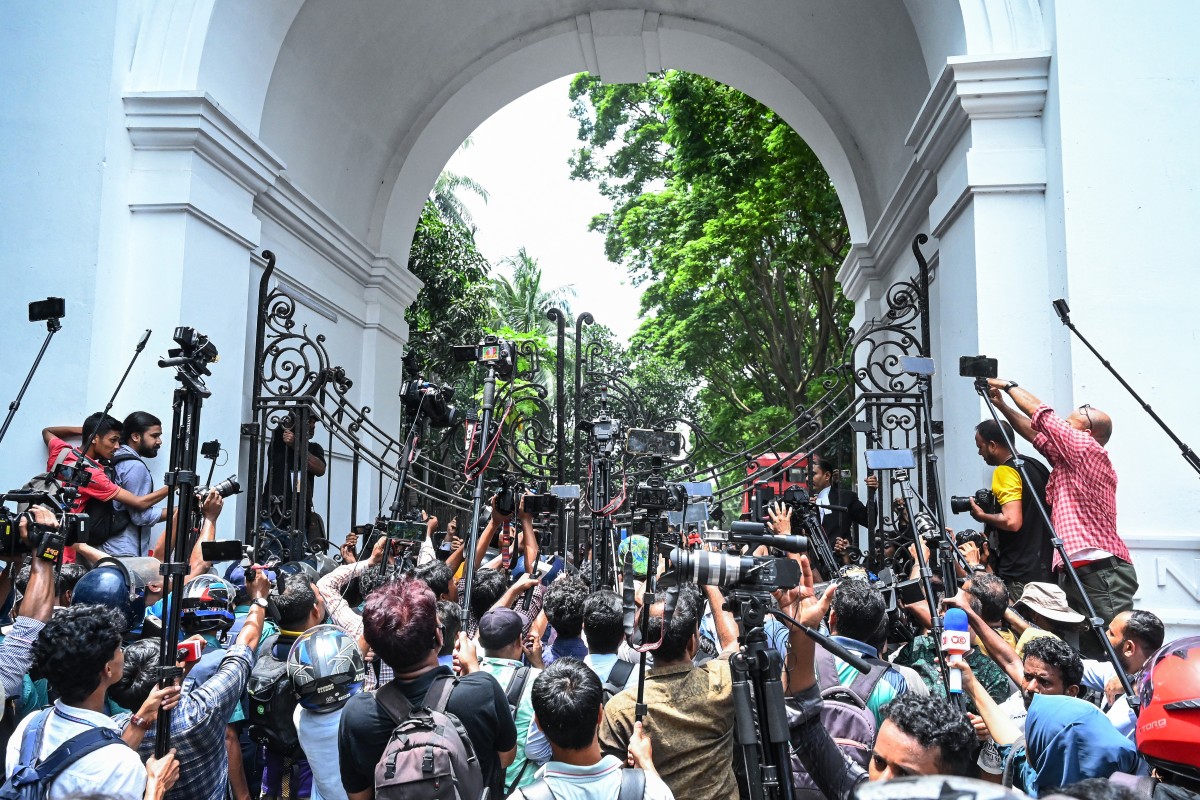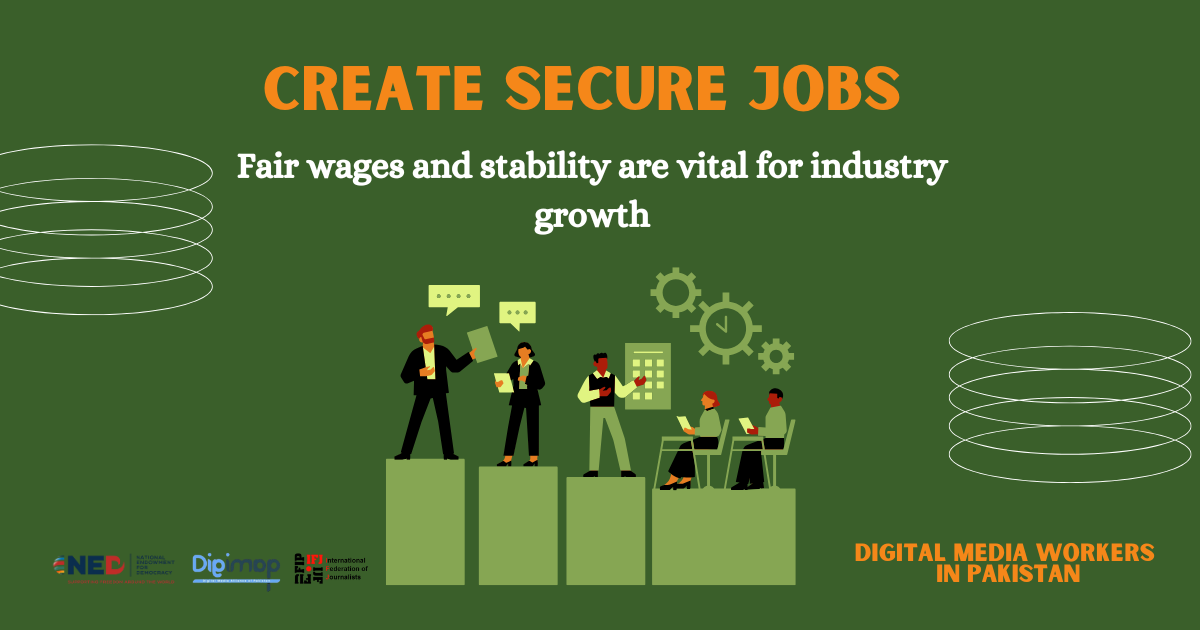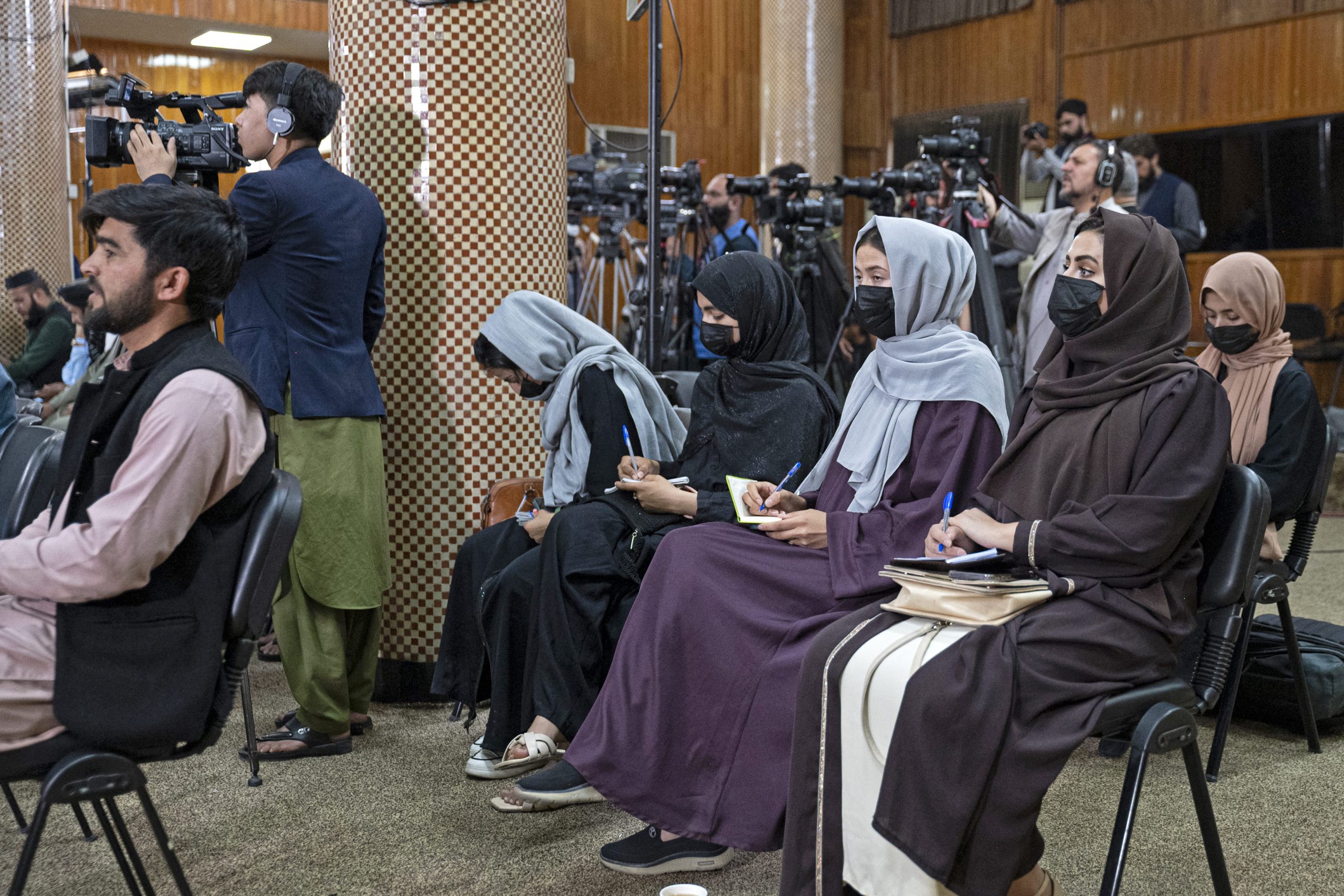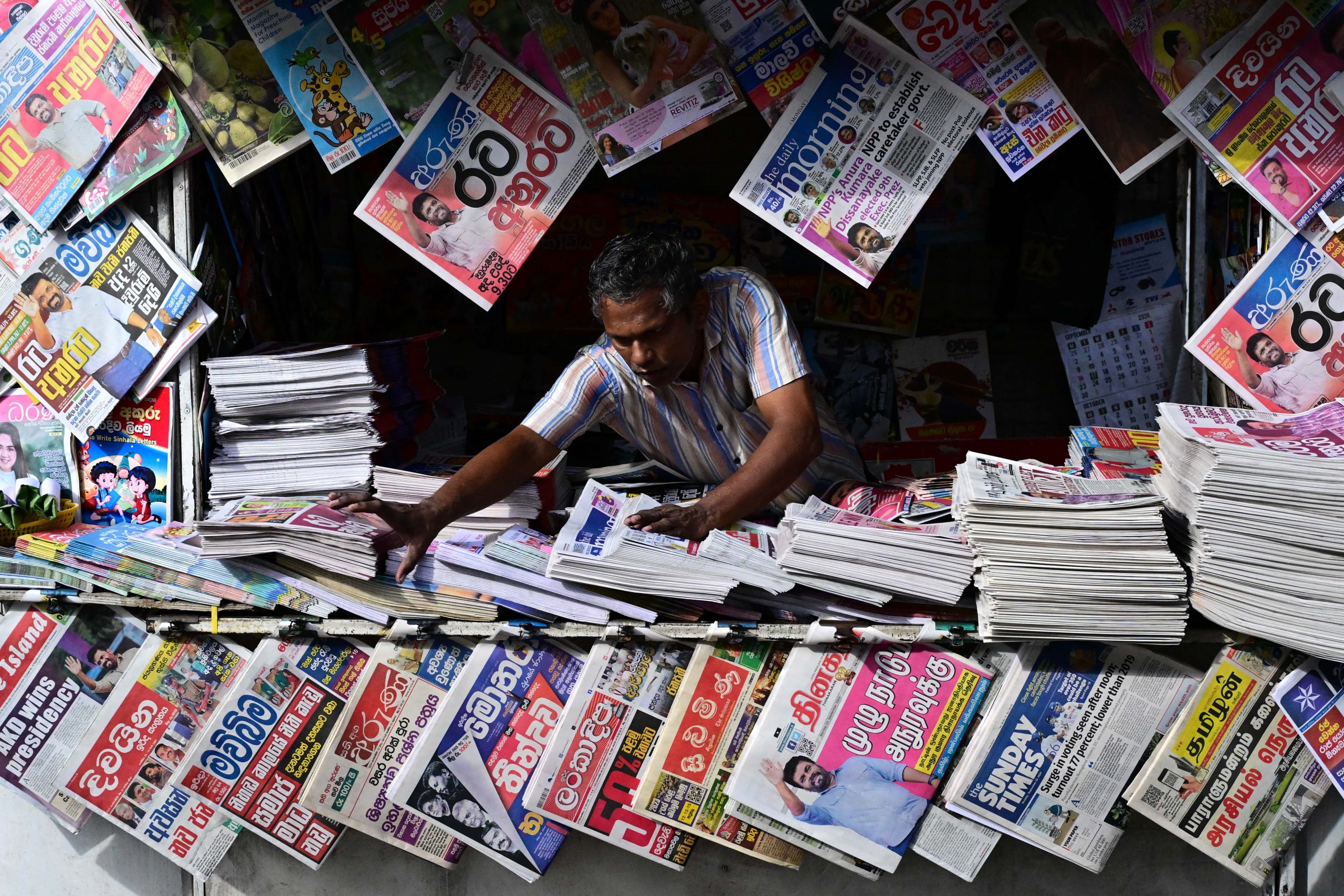REGION
The Media Gig Economy

Five journalists were killed during the anti-government protests in Bangladesh during July and August 2024, with hundreds more attacked, shot, threatened and detained. Media personnel gather near a gate of the High Court in Dhaka on July 31, 2024, as protestors call for justice for those arrested and killed in the violent nationwide demonstrations. Credit: Munir Uz Zaman / AFP
Across South Asia, news reporting and information published in the public interest continue to be severely compromised by the media industry’s ongoing economic turmoil and struggle for viability. The “defanging” of legacy media – so it is economically weakened and overly dependent on government advertising for sustaining revenue – is a widespread phenomenon across the region. Independent media across the board is also struggling to survive amid a flood of distracting content generation, some of which is Artificial Intelligence (AI)-enabled. The end result is further hastening a concerning and rapid downslide of public interest journalism.
Scores of journalists and media workers in South Asia are today staring at a future of precarity even as they join the media gig economy. Here they risk their safety and security as they valiantly endeavour to self-publish on social media platforms, or pitch for editorial space in an increasingly regulated and polarised world. In this scenario, it is little wonder that journalism, especially investigative reportage, is itself struggling to survive.
The rising tide of gig workers is now engaged in livelihoods outside the traditional employer-employee arrangement. They comprise both platform workers whose work is based on online software apps or digital platforms, and non-platform gig workers such as casual wage workers and own-account workers in conventional sectors, working part-time or full-time. According to World Bank estimates, there are now about 435 million online gig workers (including journalists, editors, and content creators) constituting at least 12.5 per cent of the global labour force.
Anti-labour laws
In India, two decades of contractualisation and the countrywide abrogation of the responsibility of newspaper managements to implement statutory Wage Board awards has ultimately resulted in the denial of a fair wage to the country’s newspaper employees. Large-scale retrenchments with little or no notice, leave alone compensation, have now become the norm.
To add to this, the scrapping of hard-fought labour laws of over six decades that prescribed the working conditions of journalists in newspapers has resulted in further weakening of journalist rights at work. The Working Journalists and other Newspaper Employees (Conditions of Service) and Miscellaneous Provisions Act (WJA), 1955, was among the 29 central labour laws repealed by the Indian government in 2019-20. When the Act was replaced by the Occupational Safety, Health and Working Conditions Code 2020, it also expanded the definition of ‘working journalists’ to cover electronic/digital media. Yet at the same time, this ended the Wage Board that protected wages and service conditions of journalists leaving journalists and media workers entitled in law only to minimum wages. Other special provisions governing termination, retrenchments, layoffs and closures or gratuity payable after specified years of service have also either been given the go-by or diluted.
Amid a sustained climate of layoffs stretching over a decade, Pakistan’s eighth wage award implementation remains minimal and still is yet to be reformed to cover electronic or digital media. An IFJ-commissioned study by the Institute for Research, Advocacy and Development (IRADA), found that gaps in the wage award’s implementation has led to media workers being increasingly engaged on contracts. In its report, IRADA estimated that approximately 80 per cent of Pakistan media employees now work under contracts or third-party contracts. Collective bargaining agreements exist in just a handful of outlets.
In Nepal, salaries of working journalists have not been increased for the past six years despite the setting up of the Minimum Wages Fixation Committee. Indeed, bad working conditions in the media industry have literally become a matter of life and death.
According to World Bank estimates, there are now about 435 million online gig workers (including journalists, editors, and content creators) constituting at least 12.5 per cent of the global labour force.

A campaign by the Digital Media Alliance Pakistan (DigiMAP) in December 2024 called for wage equality and job security for digital media workers in the country. The network was supported by the IFJ to conduct a survey of digital media workers as part of its ‘Promoting Labour Rights, Gender Equality, and Freedom of Association in Pakistan’s Media’ project funded by the National Endowment for Democracy (NED). Credit: DigiMAP
The growing information abyss
The gradual erosion of the credibility of legacy media, and the crackdown on independent media seeking to disseminate information critical of the government, has created an information abyss. With most South Asian currencies tanking against the dollar, the cost of imported newsprint, on which the print media in the region relies, is prohibitive. Additionally, governments are themselves sounding the death knell of print media, by imposing crippling new taxes and removing tariff exemptions that allow media to function as a ‘public good’. In Pakistan, the All Pakistan Newspapers Society strongly opposed this crushing of the newspaper industry and managed to roll back the proposed changes.
Media companies are increasingly focusing on leaner operations with skeletal staff, maintaining a narrow focus on daily news. A bulk of news information now flows from freelancers—reporters, researchers, photographers and videographers who all face uncertainty over assignments, fair remuneration, and timely payments.
Many of the journalists who are sacked either join the growing ranks of freelancers competing to survive or move into ancillary media jobs or better paying, more reliable gigs in communication services, content writing, project or public relations work.
The explosion in the use of social media networks as publishing platforms has aided myriad autonomous voices to self-publish, albeit in an increasingly crowded digital media space. Platforms run by transnational tech companies are now helping journalists put out stories that do not find space in legacy media. But this model also makes them vulnerable to the ever-present threat of regulation and censorship, both from the respective governments as well as the censorship and community standards of the tech platforms themselves.
Freelancers, self-publishing writers and journalists who are part of the swelling ranks of independent media gig workers are valiantly trying to bridge the gap, but for the majority, the challenges are two-fold and immense.
On the one hand there are grave concerns about the very nature of journalism and the changes in the processes of information gathering and dissemination, and on the other media gig workers are teetering on the edge of precarity. In addition, the creator economy has mushroomed and the vast ecosystem of individual influencers with their own brands, online audiences and paid for content, who move in and out of “journalistic” activity such as interviews and opinions, have disrupted traditional journalism approaches.
New realities
The dominant reality today is that most media gig workers operate with no formal contracts, and too often rely on tenuous verbal contract arrangements. From making blind pitches to developing personal links with commissioning editors, their negotiations for submitting story briefs and finalising other terms, such as travel reimbursement and a fair and timely payment for their submission, are one-sided, often dependant on the whim of the commissioning editor or the media company’s own pay standards.
Testimonies from numerous journalists reveal the extreme vulnerability faced by freelancers. “I was working on a detailed story about riot victims. I had to travel extensively to shoot the interviews, but I barely got enough to cover the travel,” said one multimedia journalist in India. Even after the story is published, payments take months to arrive, said another. “We can’t even make too much of a noise, or we’ll be seen as troublemakers and won’t get future assignments,” said a journalist who had to send several reminders to a prominent media house for payment.
In a world of information overload, where clickbait, attention grabbing and search engine optimisation (SEO) is paramount, journalists are frequently finding themselves outpaced by media professionals trained in advertising and copywriting. One journalist who worked with a television channel in India and quit to join a content writing start-up, found the rate per word abysmal, making even content writing unsustainable.
While there is no firm data available, anecdotal evidence suggests that a majority of independent media workers have moved to self-publishing and social media platforms. Forced out of legacy media, reporters and opinion makers, especially in smaller towns and districts, have taken to YouTube, Alphabet’s video publishing platform, and Facebook, Meta’s social networking platform, to publish reports.
While these newly minted media gig workers gain in terms of popularity and influence, the shift has not come without its challenges. Monetisation on YouTube is linked to the number of views and personality-led journalism, meaning only a handful of journalists manage to make enough, above the commission that the platform takes as its share.
Journalists who have shifted to platforms indicated in interviews that their reportage today is fraught with censorship, as court orders for takedowns are swiftly complied with. Furthermore, monetisation of their content sometimes skews content creation. For instance, explainer videos are more popular than ground reports or interviews, one popular YouTuber said. Maintaining journalistic standards in the race for eyeballs is the flip side of the freedom to produce and share content.
While there are platform-based initiatives in the media industry, a majority of media gig workers, freelancers, content writers, editors, photographers, graphic designers, and illustrators, are non-platform gig workers. Do they earn a fair wage that guarantees a decent livelihood, or organise collectively to demand better contracts and working conditions that guarantees their dignity? Can they be guaranteed the right to communicate information without being silenced?
This is the challenge that some unions and associations in South Asia are taking up. Through mapping and research, they are endeavouring to better understand the new realities of this growing cohort. The results of the annual IFJ Asia Pacific Affiliate Snapshot revealed that six of the ten responding South Asian IFJ affiliates listed job security and wages as a key area members most need support on in 2025. The Sri Lanka Working Journalists’ Association and the Journalists’ Association of Bhutan have made constitutional changes over the past two years to expand membership coverage, including for freelance journalists. In Sri Lanka, the Free Media Movement (FMM) listed freelance journalists as the group of media workers it wants to organise and support in 2025, and said it presented the biggest opportunity for growth, while the Indian Journalists Union said it was trying to support freelance journalists working in rural and semi urban areas. Both the FMM and the Federation of Media Employees’ Trade Unions (FMETU) listed organising gig and freelance workers as their greatest need in terms of training and support to build membership and power at work. The focus is on the future: digital, freelance, women and youth journalists.
Platforms run by transnational tech companies are now helping journalists put out stories that do not find space in legacy media.
Forced out of legacy media, reporters and opinion makers, especially in smaller towns and dis-tricts, have taken to YouTube, Alphabet’s video publishing platform, and Facebook, Meta’s social networking platform, to publish reports.

At least half of Afghanistan’s remaining media workforce currently work without wages or employment benefits. The Taliban’s authoritarian rule has systematically eroded democratic institutions and fundamental freedoms, particularly in targeting women and the press. Afghan female journalists wear facemasks as they attend a press conference in Kabul on September 19, 2024. Credit: Wakil Kohsar / AFP
Survival efforts and viability
In the Maldives, the saturation in the local media market which serves a small population and is largely confined to the capital of Male. This results in fierce competition for eyeballs and some volatility in the industry’s sustainability. Funding for media is divided between private business and state-owned enterprises, further increasing the vulnerability and susceptibility of journalists and editors.
There has been no increase in salaries of working journalists for the past six years in Nepal. In February 2025, speaking in a program organised by the Minimum Wages Fixation Committee, Nepal’s government expressed readiness to amend the Working Journalists Act (WJA) to increase the minimum wage of journalists, and accepted the government’s failure to fully implement the Act.
A legal brief furnished in the Islamabad High Court by the Institute for Research, Advocacy, and Development (IRADA), with IFJ’s support, stated that over 250,000 digital media workers in Pakistan lacked legal protections for fair pay and safe working conditions. The brief recommends legal protections against at-will termination, obligatory employer contributions to welfare schemes, compulsory gratuity, provident fund, insurance, and penalties for delayed or non-payment of wages.
Digital media networks, such as the Digital Media Alliance of Pakistan (DigiMAP) and DigiPUB News India Foundation are also both making some impact in the digital space to represent journalists within the gig economy. Though their structural model, which is based on outlet membership rather than an entirely individual journalist membership, has its limitations and an internal conflict of interest when it comes to negotiating better wages.
DigiMAP’s IFJ-supported 2024 study, Profiling the Professional Space of Digital Media Workers in Pakistan, gave some insight into the experiences and conditions of more than 100 digital media workers across its 34 member organisations. This included demographic patterns, employment terms, working conditions, professional roles, and career aspirations within Pakistan’s digital media landscape. Its survey found that the network’s digital workforce was relatively young, with 75 per cent falling in the 18 to 35 age range and was predominantly male (60 per cent men to 40 per cent women), with men occupying more technical and leadership roles. Women were more likely to be in creative, advocacy, and communication roles. The survey found the sector to be unstable and informal, with many younger workers more likely to work without formal contracts or secure employment arrangements. At least 39 per cent of journalists surveyed were employed on a regular basis, while at least 20 per cent worked on unpaid or voluntary terms.
Interestingly, DigiMAP’s research ascertained that although digital media workers generally believe that legacy media unions and the network provided moderate support for workers’ rights and welfare, there was a clear need for these organisations to focus on income generation, career growth, fair wages, and digital media training.
In a positive trend, some Pakistani digital creators managed to increase their earnings and viewership in 2024. For example, the earnings of individual Pakistan-based YouTube creators surged by 25 per cent to over PKR 10 million (USD 36,000) annually. This presents as an opportunity for stronger wage security and a potential for union organising efforts and training to maintain professional journalism standards.
Another story of hope in the gig space is that of Pakistan independent, video-first newsroom The Centrum Media (TCM). Established by Pakistani journalist Talha Ahad, TCM runs a podcast, communications arm and content studio and has a staff of more than 40 with around 18 to 20 people working on news and six people on its podcast. Its revenue streams include branded content, digital advertising, training, consultancy work and partnerships with development organisations, though it is firm that it is trying to run as a business, not as an NGO or a newsroom reliant on grant funding because of sustainability issues.
Meanwhile in Sri Lanka, the post-Covid trend of lean teams continued. Benefits such as cost of living and travel allowances, available before 2020, have not being restored, and salary cuts continue to be in effect. Some well-known newsrooms continue to delay payment of monthly salaries to permanent staff.
A Cabinet-appointed committee on March 23, 2025, recommended a series of restructuring measures for Sri Lanka’s state-owned institutions. Three state broadcasters are to be amalgamated under the new scheme for efficiency and profitability. The inevitable staff reduction will fuel an employment crisis within state media. This financial crunch is creating more problems for freelancers who are made to wait for months for payments.
DigiMAP’s research ascertained that although digital media workers generally believe that legacy media unions and the network provided moderate support for workers’ rights and welfare, there was a clear need for these organisations to focus on income generation, career growth, fair wages, and digital media training.

AI was heavily used to create deepfakes and spread misinformation during election campaigns, including resurrecting the voices of deceased leaders. Credit: Youtube and X
Disruptions in the age of AI
Apart from state regulation, journalism’s biggest challenges in this ecosystem come from the double-edged sword of technology, particularly AI. For at least four decades, rapid changes in technology in the media industry have significantly altered the production and dissemination of news.
The use of generative AI, machine learning and large language models (LLMs) is the latest and perhaps the most drastic disruptor of the news production cycle. The New York Times, Centre for Investigative Reporting and other publishers, in late 2023 took ChatGPT maker OpenAI and Microsoft to court in the USA over copyright infringement. The petitioners allege that millions of articles published by The Times were used to train automated chatbots that now compete with the news outlet as a source of reliable information, and that the defendants were liable for “billions of dollars in statutory and actual damages”. The case, which is still pending in court, will no doubt have global ramifications on the future of the industry and regulation of AI in terms of authors’ rights.
That said, the media industry is making use of AI in a myriad ways that are also still unregulated. Automation is already in use in global news agencies for generating and repackaging information to different audiences (sports highlights, weather reports, financial data, etc.), and creative work is impacted by generative AI apps. Today, AI-enabled programs are used for story selection; putting together entire reports, photographs, captions, and graphics; devising newsletters; and “basic editing tasks, including headline-writing and fact-checking.
AI-enabled news anchors are used by some broadcast channels, among them two AI newscasters on the main news broadcast of the Sri Lanka Broadcasting Corporation; Sana and Lisa in private television channels, Aaj Tak and OTV, respectively, in India; and the public broadcaster Doordarshan’s AI Krish and AI Bhoomi for agricultural news. The latter deliver updates to Indian farmers around the clock and can speak in 50 languages.
What room is there for humans in the equation when AI anchors can work 24×7 without any leave, do not need to be paid, can be programmed to work in multiple languages, and can be personalised. The impact of more widespread deployment of AI in the media sector is likely to precipitate the existing employment-related crises and further declines in the industry.
There is a clear dearth of discussion on the ethical use of AI, as well as norms to regulate it. The need for greater media literacy to educate and create awareness amongst the general public on AI-generated content has been recognised, but concrete steps are still to be taken. Journalists, unions and media houses must be at the forefront of this discussion and engage with governments and regulatory bodies.
In India, AI was heavily used to create deepfakes and spread misinformation during election campaigns, including resurrecting the voices of deceased leaders. In Pakistan, where media literacy remains limited, deepfakes are being weaponised, damaging the reputations of particularly women politicians, often through sexually explicit fabrications. Pakistan however, stands out as the first country in the region to attempt to regulate AI through the ‘Regulation of Artificial Intelligence Act 2024’, a draft of which was introduced in the Senate.
In Bhutan, the government is watchful over the use of AI by social media platforms to disseminate fake news, while in the Maldives, a Media Control Bill was scrapped following criticism it would be used against legitimate journalism instead of disinformation.
Apart from addressing the perils of using AI for spreading fake news, there still needs to be greater discussion on the challenges to laws governing intellectual property, copyright, and the fair use of digital content. This is a pressing issue, given the large volume of information that is currently generated by the media and by independent journalists, who are either freelancers or self-publish on platforms such as Medium and subscription-based apps like Substack.
What room is there for humans in the equation when AI anchors can work 24×7 without any leave, do not need to be paid, can be programmed to work in multiple languages, and can be personalised.

During the country’s presidential elections in 2024, many Sri Lankan publications were accused of blatantly violated election laws by promoting select candidates and creating divisive media narratives, inviting a slate of take down notices. A vendor arranges newspapers with front pages on the election results in Colombo on September 23, 2024. Credit: Ishara S. Kodikara / AFP
Freelancer rights
For several years, freelancers, a majority of them women, have discussed the need to strengthen protections. This includes formalised contracts with detailed elements such as timely and decent payment and the inclusion of kill fees to protect themselves when story ideas are not accepted, or when the media company to which they pitch, terminates their arrangement midway through the project.
The Network of Women in Media, India (NWMI) has come up with a charter to ensure formal contracts are given to freelancers. However, in the absence of concerted pressure from journalists, and with an ever-expanding pool of freelance labour readily available, media companies have not responded to calls for greater discussion on this issue.
In 2022, Niti Aayog, India’s premier government policy think tank, made a series of recommendations on improving the terms of employment of gig workers. The brief said that gig workers must be given fair pay, sick leave, health insurance, occupational work accident insurance, support when work is irregular, and a framework for operationalising the Code on Social Security, 2020. However, there is yet to be any progress on this.
In Sri Lanka and Pakistan, national media unions are among those developing programs to train and organise freelancers and ensure they are better represented in the broader collective, as well as in leadership.
Going forward, more of South Asia’s media unions would well benefit from conducting regular surveys of media workers to identify the categories of available work and the terms of work contracts, the use of technology, remuneration, and payment schedules. The IFJ maintains that one of the biggest potential areas for future mobilisation is the setting up of freelancer hubs or working groups within unions, to organise this growing workforce – a trend that is already well underway in other parts of the world and in the expansion of unions to cover more digital creatives.
The challenge remains to ensure that journalists continue to speak truth to power in a rapidly changing media world, despite state regulation and censorship of information through monopolistic digital distribution platforms, and despite the rise of a new gig world of work.
An informed, innovative and collective approach is vital to protect the democratic exchange of verified information within and amongst the people of South Asia. Alongside, governments must extend protections to media gig workers to end unfair labour practices and actively work to defend worker rights and decent working conditions as part of the national commitments to meeting the Sustainable Development Goals (SDGs).
Going forward, more of South Asia’s media unions would well benefit from conducting regular surveys of media workers to identify the categories of available work and the terms of work con-tracts, the use of technology, remuneration, and payment schedules.
Elimination in numbers
The rise of the gig economy has gone hand in hand with the collapse of the traditional media industry economic models and the incursion of new technologies in the creation of journalist work. Both have wrought a tsunami of job losses in the world of journalism globally.
In August 2024, an India-based media tracking website estimated that 200-400 media professionals had lost their jobs in the first half of 2024. Of these, 20 per cent were from print media, 18 per cent from television, and about ten per cent from digital media. These losses were about 15 per cent higher than in 2023.
In Pakistan, despite a massive growth in digital media, the industry has continued to weather significant job losses and financial instability over the past decade. This situation was further amplified by the Covid-19 pandemic when 8,000 out of 20,000 jobs, or two-fifths of industry roles, were eliminated.
Job shedding is not a recent phenomenon for the media sector. For more than two decades now, journalists have been pushed out of organised workplaces with alarming regularity. A survey by the Centre for Monitoring Indian Economy said that the media and publishing industry in India had witnessed job losses of a stupendous 78 per cent.
An estimated 2,500 journalists lost their jobs during the pandemic lockdown in India alone, and a significant majority scarcely received even a day’s notice from some of the biggest media houses, leave alone fair compensation. Shockingly, barely a few months later, these very same media houses put out notices for recruitment.
Reports of retrenchment in established media companies rarely provide information on the exact number of sacked journalists, much less on the terms of a painful and traumatic severance, the legal processes adopted, if any, and if monetary compensation was offered and whether it was commensurate with provisions in labour laws. This information is also not widely available through the trade union and industrial relations framework, due to the deliberate weakening of trade unionism in many countries of South Asia, despite the existence in principle and law of trade union rights and the right to collective bargaining.
Even as they ‘restructure’ for leaner operations, the hidden objective of the media retrenchment cycle is the benching of some of the most senior media employees, while fresh recruits are employed and exploited at cheaper rates. Union prohibitions are frequently strongly written into their contracts – despite the illegality of such practices.
Political upheaval has also driven further major job losses. In Bangladesh, emerging out of an intense struggle against its authoritarian government ousted amid massive public protests in 2024, the transition to a new era of democracy has not been smooth. Journalists in the country have been arrested and attacked, and their press credentials withdrawn. More than 100 senior journalists were summarily sacked after the ouster of former Prime Minister Sheikh Hasina. There have been no protections for them.
According to a survey of 30 television channels conducted by the Broadcast Journalists Centre in Bangladesh, more than 150 broadcast journalists lost their jobs in the year, mostly after Hasina’s ouster. At least 48 per cent of the channels did not provide termination benefits, while 45 per cent did not give a notice period, both of which are mandated by law. Less than half of the channels paid their workers on time, while 20 per cent kept their workers waiting for several months for salaries. Since the uprising, two television stations and one Bangla daily have been shut down, leaving hundreds of journalists and media workers jobless.
In Afghanistan, at least half of the total of 4,001 male journalists and 747 female journalists, a majority from the provinces, currently work without wages or employment benefits. According to the Afghan Independent Journalists Union (AIJU), job security is still not guaranteed even in Afghanistan’s largest media outlets.
In Bhutan, the closure of five newspapers, three radio stations and two magazines over the past decade has severely impacted employment for journalists in the tiny Himalayan nation. In addition, the viability of print media itself is a challenge, given the country’s relatively small economy, scarce resources, the government’s e-procurement policy on the award of tenders, and the grant of government advertisements to websites instead of print media.
